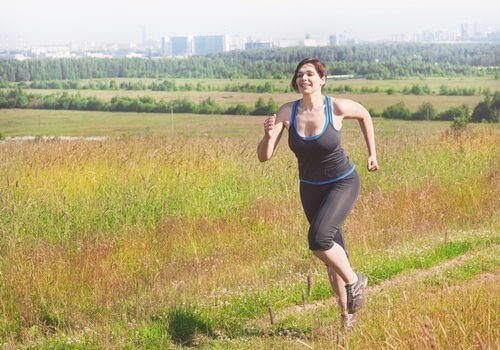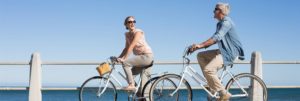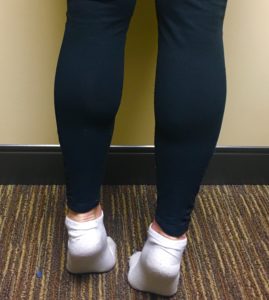
Varicose veins are veins that become enlarged or stretched out due to blood that pools in the legs. In addition to making your veins bulge, they can cause the following symptoms:
Since varicose veins are primarily caused by inactivity in the legs over a long period of time, getting out there and doing some exercises can help prevent and alleviate the symptoms associated with varicose veins.
While there’s no way to completely prevent varicose veins, regular exercise can help reduce the chances that you’ll get them. Simply changing your sitting or standing position regularly can improve your blood circulation, which helps reduce the amount of blood swelling the veins in your legs.
Exercise can increase your body’s ability to pump blood up the leg back toward the heart. It also helps keep your weight down, which further decreases your chances of getting varicose veins. Walking is a good choice, as are low-impact activities, such as swimming and biking.
If you already have varicose veins, exercise can keep them from getting worse and also help alleviate pain and discomfort. Generally, low-impact exercises are best, and include the following:

Walking just 30 minutes a day for five days a week can yield good benefits. If you run, try to find a grassy surface or synthetic track to minimize the stress on your joints.
You need to do this move regularly to see the benefits. But the great news is that this is one of the exercises for varicose veins that require no equipment. To start your leg lifts, sit or lie on your back while sticking your feet straight out. Lift one leg at a time up, holding it in the air. Slowly lower it down and repeat with the other leg.
Riding a bike or stationary bike is also helpful. It strengthens your calf muscles, which helps pump blood out of your legs and keeps it flowing in the right direction. If you don’t have access to any kind of bike, you can try this bicycle legs exercise. While lying on your back, put your legs in the air, bending them at the knee. Pedal them slowly as if you are bicycling. Try both legs at once, or alternate one at a time.
Working your leg muscles sends more blood to your heart. That makes your heart work harder, so it's ready to do the important job of circulating blood through your body. To get into proper lunge position, stand with your legs apart. Step forward slowly, bending your knee and making sure to keep your knee directly above your ankle. Hold it, then slowly straighten your leg and step back to your original position. Repeat with the other leg. While standing with your legs straight, rise up on your tiptoes and then lower back down. Repeat.
Like calf raises (see below), rocking your feet can strengthen leg muscles that are important for your circulation. Then, as a bonus, it can also help you improve your balance! Ready to give it a try? While you’re sitting or standing, rock your feet back and forth from heel to toe. This can be done at any time and is also helpful if health conditions prevent you from trying other forms of exercise.
When you suffer from chronic vein disease, you are vulnerable to venous leg ulcers: hard-to-heal sores that develop on your legs due to a combination of damaged capillaries and lymphatic ducts, and lack of oxygen in your lower legs. Once they develop, ulcers are hard to heal because, once again, of the shortage of oxygen reaching your lower limbs.
Fortunately, managing your vein disease with doctor-approved exercise can help protect you from developing ulcers. And, if ulcers have already formed, new evidence suggests that certain exercises may speed up your healing process!

According to Dr. Laura Bolton, a member of the Wounds advisory board, evidence suggests that structured exercise training (SET) can help speed up the healing process for both venous leg wounds and diabetic foot ulcers. Chief among those exercises included in the SET program? Calf raises, thanks to their ability to get the heart pumping and improve circulation to the lower extremities.
In her study, 77% of patients with venous leg ulcers had completely healed after a 12-week progressive exercise program; only 53% of non-exercisers enjoyed the same result. When it came to diabetic foot wounds, individuals who exercised for just 30 of the 96-day trial window saw a dramatic result in the size of their ulcers.
In revealing her findings, Bolton said: “This suggests that the more patients engage in calf muscle exercise, the more and earlier they improve their chronic VLU or DFU healing...[This could lead to saving] limbs and lives of patients. ”
While no vein disease patient should engage in a new exercise routine without a doctor's supervision, it is a good idea to discuss your physical activity once you've been diagnosed with vein health issues. Ask your doctor if it is safe to try this calf-raise routine, and you may just enjoy preventative or healing health benefits!
Position yourself on a staircase, with your hands resting against a wall or a sturdy object for balance and your heels hanging off the back edge of the stair. Raise your heels a few inches above the edge of the step so that you're on your tiptoes. Hold the position for a moment, and then lower your heels below the platform, feeling a stretch in your calf muscles. That's one rep; aim for three sets of 10-15 reps each. Please note that you may have to build up to that level of performance.
Exercise can be helpful when dealing with varicose veins, but you may also need treatment to achieve better results. Texas Endovascular offers minimally invasive, in-office procedures that don’t require general anesthesia or sedation. Several different treatment options are available for varicose veins, and each requires little or no recovery time. In fact, most patients are able to return to work the same day. We’ll choose the procedure that will yield the best results in your particular case, improving your comfort level as well as appearance.

Scheduling
Please contact our dedicated specialists to schedule a consultation today.
2025 Texas Endovascular. All rights reserved. Website Design by Healthcare Success